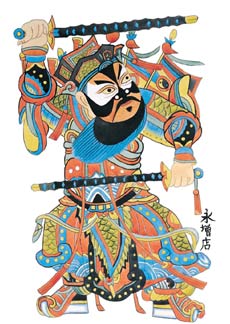| Paint the Town Red |
| http://www.sina.com.cn 2005/03/31 19:48 thats China |
Our guide to Chinese New Year's diverse decor By Vanessa Mulquiney The Spring Festival's most popular symbols are more than just pretty decorations. From red socks to knot hangings, each decoration has its own tale to tell. Door gods (men shen)
Just before the Lunar New Year (this year falling on February 9), pictures of two ancient generals - known as door gods - are placed in front of entryways as protection for the home. The tradition began in the Tang Dynasty (618-907), when Emperor Taizhong experienced bad dreams about ghosts and spirits. In fear, the emperor ordered two generals to safeguard his bedroom and soon enough the emperor was sleeping soundly. The emperor eventually relieved the soldiers of their duty, but ordered that a painting of each general be made and hung on his bedroom door. The tale became widely known and soon people were making their own door gods to protect them against unwanted ghostly visits. This phenomenon can only be seen in some scattered villages now.
Spring couplets (chun lian) As the legend goes, tracing back to the Zhou Dynasty (1046 B.C.-256 B.C.), two generals has the daunting job of protecting the God of Heaven's peach trees from demons. The generals were so successful at fighting the demons away that families carved peach wood statues of the pair and placed them at the front of their homes to scare away demons. Today, the tradition continues, albeit in a simplified version, as scrolls and squares that are hung on either side of the door. The scrolls feature two rhyming sentences expressing hopes and good wishes for the coming year. Fu (福) The character fu, usually painted on red, diamond-shaped paper, can be seen in almost every household and is usually hung upside down. Those who hope for extra luck and fortune do this deliberately: The pronunciation of fu dao - or "luck upside down" - is similar to the phrase "luck arrives." In other words, good luck will arrive and is welcome to enter the house. Red Not only do people deck their homes with red decorations, but they also adorn themselves with the lucky hue. Red is considered a cheerful color that will bring the wearer a favorable future. Many Chinese steer clear of black and white during the festive season, as these colors are associated with mourning. Prefer to be low-key? Red underwear, socks or a belt is enough for good luck. Just dress wisely: It is said that one's appearance on New Year's sets the tone for the whole year. Greeting cards Sending New Year's greeting cards to friends and family is a Chinese tradition that started in the Song Dynasty (960-1279). At first, only the highest class exchanged New Year's cards in a show of status. But around the start of the Ming Dynasty (about 400 years later), it became a common practice for ordinary people to exchange cards. Now the giving and receiving of cards is a way for friends and family to keep in touch.
|
|
|
|
|
|
| Annotation |
| 新 闻 查 询 |
| 热 点 专 题 | ||||
| ||||
|
教育频道意见反馈留言板 电话:010-82628888-5747 欢迎批评指正
新浪简介 | About Sina | 广告服务 | 联系我们 | 招聘信息 | 网站律师 | SINA English | 会员注册 | 产品答疑
Copyright © 1996 - 2005 SINA Inc. All Rights Reserved
版权所有 新浪网![]() 北京市通信公司提供网络带宽
北京市通信公司提供网络带宽

